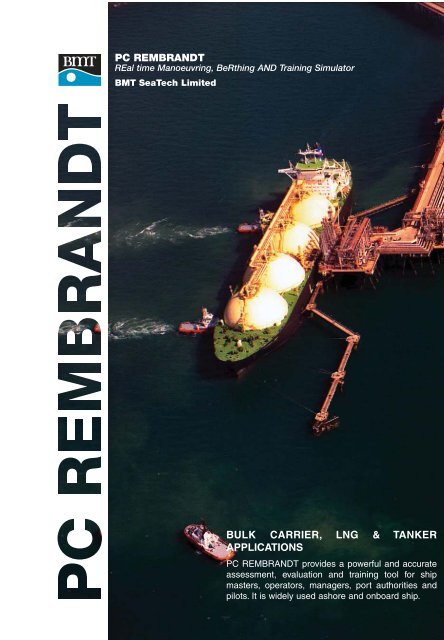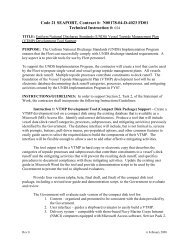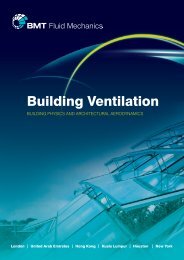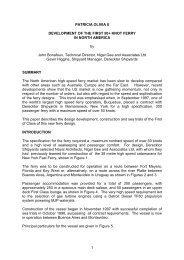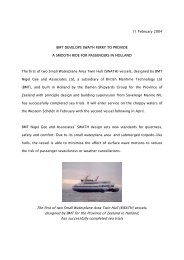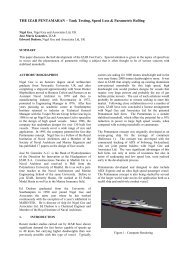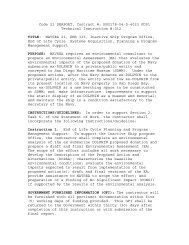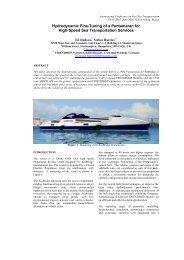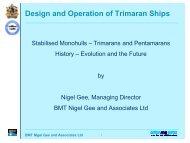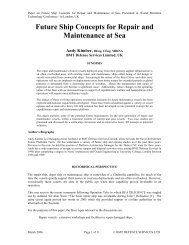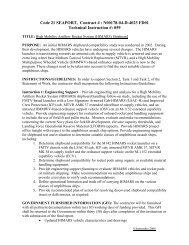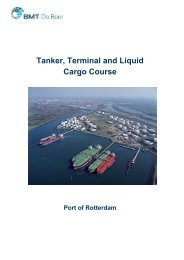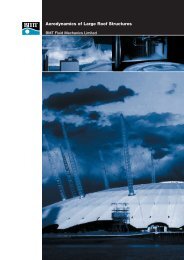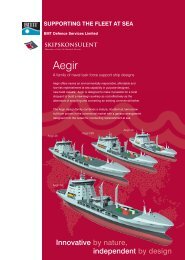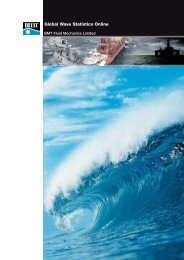PC Rembrandt General Description
PC Rembrandt General Description
PC Rembrandt General Description
- No tags were found...
Create successful ePaper yourself
Turn your PDF publications into a flip-book with our unique Google optimized e-Paper software.
<strong>PC</strong> REMBRANDTREal time Manoeuvring, BeRthing AND Training SimulatorBMT SeaTech LimitedBULK CARRIER, LNG & TANKERAPPLICATIONS<strong>PC</strong> REMBRANDT provides a powerful and accurateassessment, evaluation and training tool for shipmasters, operators, managers, port authorities andpilots. It is widely used ashore and onboard ship.
GENERAL DESCRIPTIONBMT SeaTech Limited has many years experience in all aspects of ship manoeuvring fromfull scale trials, free running and captive model tests to mathematical prediction andsimulation. <strong>PC</strong> REMBRANDT V4.0 is an interactive and user friendly <strong>PC</strong> basedmanoeuvring simulator, based on this extensive experience.Introduction<strong>PC</strong> REMBRANDT is a real and fast time ship-handling andmanoeuvring simulator. It is <strong>PC</strong> based and designed using standardWindows user interfaces and structure to ensure user-friendliness. It isprincipally designed for the following applications;• Manoeuvre rehearsal• Ship performance and operational assessments• Assessment of port arrangements (berths, channels, etc)• Assessment of tug requirements• Ship-handling training• Incident investigations<strong>PC</strong> REMBRANDT uses industry standard electronic charts as theinteractive simulation backdrop enabling the mathematical model tointeract with the bathymetry and land objects contained within the vectorchart data. Mathematical ship models are based on specific ships andare modelled individually by BMT SeaTech, based on many yearsexperience in the manoeuvring performance of surface vessels.<strong>PC</strong> REMBRANDT V4.0 Features<strong>PC</strong> REMBRANDT V4.0 includes the following principal features:• Full ENC / ARCS chart display and functionality giving use ofindustry standard electronic charts for simulations with worldwidecoverage for minimal additional costs.• 3-D visual databases for all vector charts generated at no cost andproviding an ‘out of the bridge’ view from the ship, including nighttimeviews and reduced visibility settings.• 3-D and cross-section (2-D) underwater profiles showing the localbathymetry and channel dimensions.• An upgraded mathematical model including bank effects,dynamic squat, ship – ship interaction and wave forces.The simulator includes many of the features found on modern Integrated Bridge Systems (IBS) and isavailable with a number of additional modules including, spatially variable currents, anchors, mooring lines,tugs and 3D traffic vessels.The electronic charts are typically purchased by the end-user through their normal chart procurementprocesses. The charts used on-board a vessel (i.e. S-57 ENC or ARCS) can be used in the simulator.Ship models can be created individually for a client based on a specific ship or can be chosen from a libraryof nearly 100 vessels. All ship models are validated by BMT SeaTech with assistance from nautical staff.Dedicated control consoles can be supplied that utilise the same controls as the ship, therefore providinga realistic control interface to the simulator. These can be designed to match the layout on-board the ship.BMT SeaTech Ltd Page 2 of 7 <strong>PC</strong> REMBRANDT V4.0
Ship ModelsAll hydrodynamic ship models are created by our team of experienced Hydrodynamicists and NavalArchitects. Vessels are individually modelled to reflect the characteristics of a ship or Class of ship. Allvessels mathematically modelled for <strong>PC</strong> REMBRANDT are fully validated and can be supplied singularlyor as a library of different ships. For example, each license placed on-board a particular ship could be shipspecific, yet a shore-based system could be configured to provide the option of simulating any ship in aparticular fleet or a range of ship types common in a particular port.Most ship types can be accommodated on the simulator, including:• Bulk carriers• Gas carriers (LNG / LPG)• Container ships• <strong>General</strong> cargo• Cruise ships• Tankers (coastal → ULCC)• Ferries (ro-pax)• WarshipsA wide range of environmental conditions, hydrodynamic effectsand control systems can be modelled including:• Wind (gusting), tide, current and waves• Bank effects, squat, and ship-ship interaction• CPP, podded propulsors and azimuth thrusters• Conventional, high-lift and flapped rudders• Diesel, diesel-electric and gas turbine propulsion systems• Joystick and DP controls.Standard ‘library’ vessels of a range of different merchant and naval shiptypes are also available.Each ship model goes through a comprehensive validation process, where the mathematical model isprepared by BMT SeaTech and validated against sea trials or model test information and against our ownexperience based on our extensive database of ship manoeuvring data. Following this first ‘phase’, theship model is evaluated by a person familiar with the handling of the vessel, such as a Master or local Pilot.It is our aim to ensure that every ship model is indistinguishable in performance from the real ship.Electronic Charts and 3D Visuals<strong>PC</strong> REMBRANDT V4.0 is compatible with the following format electronic charts which provide theinteractive ‘backdrop’ to the simulations:• ENC: Standard ENC’s produced to the standard S57 data format (notSENC).• ARCS: ARCS charts stored in their natural Hydrographic Office (HO)format.• BMT: Standard BMT format charts converted initially from C-Map’sCM93/2 database.ENC and ARCS charts may be purchased from normal nautical chartdistributors and provide extensive coverage of world-wide ports andnavigable areas. For <strong>PC</strong> REMBRANDT systems used on-board, thesame charts can be used on <strong>PC</strong> REMBRANDT as on the ship’s IBS.Where vector charts (ENC and BMT formats) are available <strong>PC</strong>REMBRANDT can create a 3-D visual scene directly from the electronicchart. The 3D visual scene is created automatically at no additionalcost, therefore removing the cost of expensive port databases. All seabedcharacteristics, land areas, major landmarks and aids to navigationdefined by the chart are created and displayed in the 3D view. Thisincludes all defined navigational light sectors, ranges and sequences.The user many move around the visual scene at will and may use pre-defined viewpoints including bridgeview, bridge wings and bridge wing views looking aft. Both visibility (to reflect the reduction due to fog)and daylight settings may be varied.BMT SeaTech Ltd Page 3 of 7 <strong>PC</strong> REMBRANDT V4.0
Software Modes and FeaturesThe facilities of <strong>PC</strong> REMBRANDT V4.0 include:• Real or fast time simulations with the facility to pause orfast forward at any time.• Three chart display modes to suit individual preferences:Bow or track up, North up or fixed chart.• Historical and future position displays, heading line andanalogue or digital gyro-compass.• Customisable display with saveable panel layouts.• Fully variable environmental conditions (wind, tide,current and waves).• Save and re-load facilities with re-play in real or fasttime for use in briefing / de-briefing sessions for thebridge team and pro-active training sessions.• Detailed simulation reports, including position plots,graphs and tabular formats.• The ability to save simulations as scenario files, basedon a particular port and environmental conditions.• On-screen pivot point indicator, showing its positionalong the length of the ship.• The ability to interrogate chart information forfamiliarisation with the characteristics of a particular port.• Accurate waypoint plotting on the electronic charts torepresent particular tracks, enabling <strong>PC</strong> REMBRANDT tobe used for passage planning and training.• User defined ‘hard-quays’ and dolphins as part of theberth arrangements. The ship interacts with these anddisplays the impact velocity accordingly.• Placement of stationary vessels on the electronic chart torepresent moored vessels in a particular port.• The use of traffic vessels in simulations to representother port traffic, therefore increasing the realism ofmanoeuvres.• Channel cross-section view showing the position of theship at bow and stern in a channel, when comingalongside a berth or in shallow / confined water.• User defined spatially variable currents in simulations,therefore taking into account the turning effect when thebow and stern are in different tidal streams.• Use of up to six tugs in simulations, allowing the effectsof tug assistance to be incorporated into simulations.• The ability to use anchors and mooring lines duringsimulations, therefore allowing the dynamic effects ofmooring lines and anchors to be included in the ship’smathematical model.• Use of navigational aids such as Range & Bearingmarkers, range rings and parallel index lines duringsimulation, to assist with navigational exercise andincrease the realism of a particular manoeuvre.• Interactive help facilities and a detailed user guide.<strong>PC</strong> REMBRANDT V4.0 may be supplied with the following optional modules:BMT SeaTech Ltd Page 4 of 7 <strong>PC</strong> REMBRANDT V4.0
Joystick Control ModuleMost vessels are controlled ‘conventionally’ with separate engine, rudder and ifappropriate thruster controls. This software option provides the ability to simulatethose vessels with ‘joy-stick’ type of controls. It enables the ship’s officers tofamiliarize themselves with this type of ship’s control system and its associatedmethodologies which can be very different from those experienced whenmanoeuvring with separate telegraph, rudder and thruster controls.The ‘joy-stick’ control option is an emulation of the actual vessel’s on-boardcontrol algorithms and permits separate control of ship’s track and velocity (viathe joy-stick itself), rate of turn and centre of rotation.<strong>PC</strong> REMBRANDT V4.0 is also available with a direct link to a real DynamicPositioning (DP) system, therefore simulating the response of the ship and theindividual control devices to the control demands issued and providing feedbackto the DP system.Tugs Module<strong>PC</strong> REMBRANDT v4.0 includes the facility to simulate the subject vessel with upto six tugs operating simultaneously. Each tug has individual control of tow, pulland direction. Each port can be configured with the exact tugs available to thevessel (tug name, bollard pull capability, bow or stern pull etc) to facilitate theaccurate rehearsal of an individual manoeuvre. Alternatively, each port canutilize a ‘library’ of typical tugs.With each simulation, reports and graphs are easily printed showing the forcesand turning moment applied to the vessel by each tug, facilitating analysis andoptimization of tug usage. Control of each tug enables the contact point, forcemagnitude and direction to be adjusted throughout the simulation. The screendisplays the tug mode (push/pull), force direction and position along the hull.The tug module can be used to assess the tug requirements (bollard pull) for anew port or development. Tugs may be used to assist berthing operations or inan escort mode, whereby the required bollard pull can be easily determined.Spatial Currents ModuleThe software user can define areas of specific current velocity and directionover the electronic chart backdrop. When a number of areas are defined, thiscreates a detailed current map that can be saved with a height datum torepresent a specific state of the tide e.g. high water, low water, slack wateretc.There is no restriction on the size of each area and they can be individuallyedited and rotated as applicable. During a simulation, the user has the optionof showing the tidal vectors superimposed on the electronic chart backdrop.As a simulation progresses the vessel will move between different tidalstreams and the effect of these will be automatically incorporated into thesimulation, including the turning effect when the bow and stern are indifferent currents. This feature is particularly beneficial when the tidalstreams are complex in the vicinity of the berth or berth approach.Databases of time and spatially variable current data may also be used with<strong>PC</strong> REMBRANDT V4.0.BMT SeaTech Ltd Page 5 of 7 <strong>PC</strong> REMBRANDT V4.0
Anchors and Mooring Lines ModuleThe Anchors and Mooring Lines module for <strong>PC</strong> REMBRANDT v4.0 enablesthe simulation to include the dynamic effects of mooring lines and anchors.Each vessel has its mooring equipment individually modelled and the user willdefine the location and height above chart datum for the shore-side mooringpoints or bollards. Once defined these can be saved and will automatically beloaded with the electronic chart.The mooring lines will be applied between the vessel and the fixed mooring points with the user having theability to ‘veer’, ‘heave’ or ‘avast’ the line accordingly. The status of each line (slack or taught) will bedepicted together with an indication of the load relative to the line’s maximum. Individual lines can be ‘tiedto bitts’ and winches may be used in an ‘auto-tension’ mode.3D Visuals for traffic and stationary vesselsThe hawse pipe positions, chain properties and winchspeeds of each vessel will be individually specified. Theanchor will be deployed by the user onto the electronicchart where the option will be available to ‘veer’, ‘heave’,‘avast’ or ‘let go’ chain as necessary. The status of eachline (slack or taught) will be depicted together with anindication of the load relative to the line’s maximum.Users may define the seabed type, allowing thesimulation to include the difference in anchor holdingpower for different seabed compositions<strong>PC</strong> REMBRANDT v4 utilizes industry standard 3D visual models of thesimulated vessel. In addition this software option provides the user with theability to display and simulate the 3D views including stationary and trafficvessels. The option includes a generic database of 3D visual models(see Appendix C) each of which may be scaled by the user to adjust lengthand breadth.Track-pilot ModuleThe track-pilot module for <strong>PC</strong> REMBRANDT V4.0 is based on a commercially available Integrated BridgeSystem ‘track-pilot’ and enables users to conduct simulations automatically using pre-defined tracks orseries of waypoints.The ‘pilot’ of each ship is individually modelled to reflect the ship’s response to helm and can include afull ‘track-pilot’ as well as heading and course pilots. Individual tracks can be plotted and saved for futurereference, allowing realistic tracks to be used in the evaluation of a particular passage or manoeuvre.The track-pilot function allows the user to define individual waypointattributes and displays all of the relevant navigational information onscreentogether with appropriate warnings / alarms, such as ‘off-course’and ‘Cross-track distance’. Based on these waypoints the simulatedvessel is manoeuvred by the software's pilot to maintain the desiredtrack subject to the manoeuvring capability and characteristics of theindividual ship. The simulation may then be viewed in real-time, fast-timeor report mode.The Track-Pilot mode allows the feasibility of a particular manoeuvre orport approach to be rapidly assessed and through a summary tabularreport and deviations from the desired track it will highlight any particularelements of the manoeuvre that require further attention. These canthen be simulated and further evaluated in real-time. Typical applicationsof the Track-Pilot include the assessment of the environment on avessel’s safe operating envelope and in optimising the design of newport facilities and pilotage.BMT SeaTech Ltd Page 6 of 7 <strong>PC</strong> REMBRANDT V4.0
<strong>PC</strong> REMBRANDT V4.0 Hardware<strong>PC</strong> REMBRANDT is designed to run on the following specification <strong>PC</strong>:• 3GHz+ Processor• AGP Graphics Card Slot• Windows 2000 or XP• 512 Mb of RAM• CD ROM Drive• Minimum 32 Mb OpenGL 2 compatible Graphics Accelerator Card(specific recommendations available)• 2 x SVGA (1280 x 1024 pixel) monitors• 500Mb of hard disk spacePurpose-built control consoles are available from BMT SeaTech for usewith <strong>PC</strong> REMBRANDT. The consoles are designed to replicate a ship’scontrols layout and include industry standard control levers from Stork-Kwant and other manufacturers. Both desktop and Integrated BridgeSystem style console are available and all consoles are ‘plug and play’,using a single serial connection to the simulator <strong>PC</strong>.The use of a control console allows the user to navigate and manoeuvrethe ship using real ships controls, therefore increasing the realism ofthe simulation by providing ‘hands-on’ control of the ship.<strong>PC</strong> REMBRANDT Applications<strong>PC</strong> REMBRANDT is regularly and effectively used by pilots, ship operators, naval architects and portauthorities for:• The assessment of safe operating limits in a particular port under varying environmentalconditions, including under-keel clearance.• Use of alternative methods of control, such as tugs and the optimisation of tug usage.• Assessment of tug requirements for a given vessel in a particular port under definedenvironmental conditions• Evaluations and risk assessments for new or proposed berths, terminals, approaches andchannel design.• Port familiarisation, manoeuvre rehearsals and verification of passage plans.• Familiarisation of officers and pilots with the handling characteristics of a new vessel• Training of junior and senior officers (and pilots) in ship-handling and the aspects particular to awide range of ship types.<strong>PC</strong> REMBRANDT may be used at a client’s office (shore-side) to provide overall company use as well ason-board ship, where it is ideally suited to the rehearsal of manoeuvres (with or without pilots) prior tocommencement, the verification of passage plans and for providing junior officers with ship-handlingexperience that they would otherwise not receive.<strong>PC</strong> REMBRANDT v4.0 may be combined with an advanced Ship-handling Computer Based Trainingpackage to provide a formal and assessable structure to on-board training. It may also be combinedwith a navigational predictor (integrated into the ships IBS) giving a more accurate future positiondisplay on the ship’s ECDIS and the capability to re-play actual manoeuvres VDR style.For further information on <strong>PC</strong> REMBRANDT, please contact BMT SeaTech Ltd at;e-mail: pcrembrandt@bmtseatech.co.ukTel: +44 (0)23 8063 5122Fax: +44 (0)23 8063 5144BMT SeaTech Ltd Page 7 of 7 <strong>PC</strong> REMBRANDT V4.0


